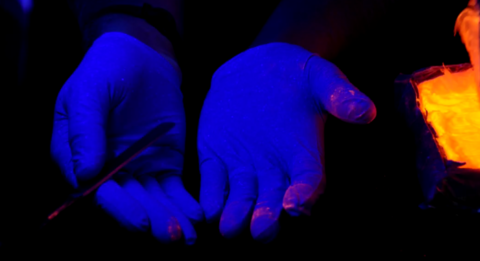In Glowing Colors: Seeing the Spread of Drug Particles in a Forensic Lab
Black-light videos from NIST will help crime labs manage an invisible risk.

NIST researchers used glowing powder to understand how drug particles can be spread onto surfaces in a forensic chemistry lab.
When two scientists from the National Institute of Standards and Technology (NIST) brought black lights and glow powder into the Maryland State Police crime lab, they weren’t setting up a laser tag studio or nightclub.
Instead, their aim was to study the way drug particles get spread around crime labs when analysts test suspected drug evidence. Their study, recently published in Forensic Chemistry, addresses safety concerns in an age of super-potent synthetic drugs like fentanyl, which can potentially be hazardous to chemists who handle them frequently.
The spread of drug particles cannot be completely avoided — it is an inevitable result of the forensic analyses that crime labs must perform. To see how it happens, the two NIST research scientists, Edward Sisco and Matthew Staymates, fabricated a brick made of white flour mixed with a small amount of fluorescent powder. Under everyday lights the brick looked like evidence from a drug seizure, but under ultraviolet light — also called UV or black light — it glowed a bright orange.
Amber Burns, supervisor of the Maryland State Police forensic chemistry lab and a co-author of the study, examined the brick and its contents as she would real evidence. With a sheet of butcher paper covering her workspace, she cut open the package with a scalpel, scooped out a sample and transferred that scoop into a glass vial for analysis.
She also removed the powder to weigh it on a digital scale without the packaging. When she was done, the black light revealed that some particles had settled onto surfaces in her workspace. Some had also adhered to her gloves and were transferred by touch onto a marker and wash bottle.
All chemists clean their workspaces between cases to prevent evidence from one case from contaminating the next. After Burns discarded the butcher paper and cleaned her workspace, the black light showed that her cleanup routine was effective.
Before the emergence of fentanyl and other super-potent drugs, such small amounts of drug residue were not a major concern. But that has changed, and not only for reasons of workplace safety. Drug dealers often mix small amounts of fentanyl into heroin and cocaine, and some labs are increasing the sensitivity of their instruments to detect those small amounts. Highly sensitive instruments are more likely to detect small amounts of drug residue in the environment, so those labs have to be extra careful about limiting their spread.
This visualization experiment led the authors to suggest several steps that might minimize spread. These include changing gloves frequently, using vials and test tubes with large mouths to limit spillage when transferring material into them, and having two sets of wash bottles, one for casework and one for cleanup.
The researchers’ paper is written in such a way that any laboratory can reproduce the black-light experiment.
“This is a great way for labs to see which of their practices contribute to the spread of drug residues, and to make sure that their cleanup routines are effective,” Sisco said.
Paper: E. Sisco, M.E. Staymates, A. Burns. An easy to implement approach for laboratories to visualize particle spread during the handling and analysis of drug evidence. Forensic Chemistry. Published online March 11, 2020. DOI: 10.1016/j.forc.2020.100232

